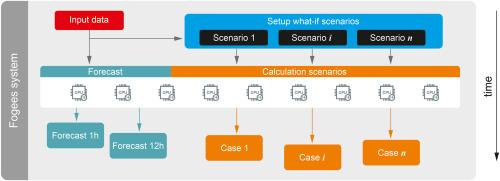Using an operational air pollution forecast system for evaluation of local emission abatement policy scenarios
IF 3.7
2区 环境科学与生态学
Q2 ENVIRONMENTAL SCIENCES
引用次数: 0
Abstract
Effective policy to reduce urban air pollution requires the identification of appropriate solutions to achieve it. Where funding is limited, interventions should result from a previous analysis of strategic effectiveness. In this work, an air pollution forecasting system was used to assess the effectiveness of strategies for reducing emissions from domestic furnaces; the system facilitates forecasts of average hourly concentrations of pollutants, down to street scale (pedestrian level). The analysis was carried out for a city in which exceedances of the PM10 concentration are recorded, due to emissions from domestic furnaces burning solid fuels. A criterion for identification of local pollution hotspots was proposed, determined as part of the calculations for current emission data (base scenario). The effectiveness of four potential emission reduction scenarios was evaluated. The first two scenarios concern the elimination of a specific centile of the highest emitters among domestic furnaces. Two further scenarios included a reduction of the same total number of sources; however, the distance from the pollution hotspots areas identified in the baseline scenario was used as the emitter elimination selection criterion. The results indicate that for the study area the implementation of any of the scenarios considered would allow the elimination of all existing hotspot areas. Nevertheless, the results indicate variation in the effectiveness of individual scenarios on a city-wide scale in terms of the reduction in the number of exceedances of hourly and daily concentration limits, the impact on air quality and the population exposed to excessive levels.

利用可运作的空气污染预测系统,评估本港的减排政策方案
减少城市空气污染的有效政策需要确定实现这一目标的适当解决办法。在资金有限的情况下,干预措施应基于先前对战略效力的分析。在这项工作中,使用了空气污染预测系统来评估减少家庭炉排放战略的有效性;该系统有助于预测污染物的平均每小时浓度,精确到街道尺度(行人水平)。该分析是在一个城市进行的,在这个城市,由于燃烧固体燃料的家庭炉子的排放,PM10浓度超标。提出了一项确定当地污染热点的标准,作为当前排放数据(基本情景)计算的一部分加以确定。评估了四种可能的减排情景的有效性。前两种方案涉及消除家庭炉中排放最高的特定百分位数。另外两种设想包括减少相同的来源总数;然而,在基线情景中确定的污染热点区域的距离被用作消除排放源的选择标准。结果表明,对于研究区域,实施所考虑的任何情景都可以消除所有现有的热点区域。然而,研究结果表明,在全市范围内,就每小时和每日浓度超标次数的减少、对空气质量的影响和暴露于超标水平的人口而言,个别方案的有效性存在差异。
本文章由计算机程序翻译,如有差异,请以英文原文为准。
求助全文
约1分钟内获得全文
求助全文
来源期刊

Atmospheric Environment
环境科学-环境科学
CiteScore
9.40
自引率
8.00%
发文量
458
审稿时长
53 days
期刊介绍:
Atmospheric Environment has an open access mirror journal Atmospheric Environment: X, sharing the same aims and scope, editorial team, submission system and rigorous peer review.
Atmospheric Environment is the international journal for scientists in different disciplines related to atmospheric composition and its impacts. The journal publishes scientific articles with atmospheric relevance of emissions and depositions of gaseous and particulate compounds, chemical processes and physical effects in the atmosphere, as well as impacts of the changing atmospheric composition on human health, air quality, climate change, and ecosystems.
 求助内容:
求助内容: 应助结果提醒方式:
应助结果提醒方式:


